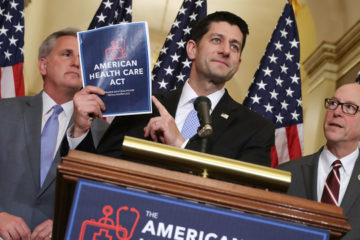his Obamacare Rule Keeps You Out of the Hospital. Will It Survive?

published Mar 10th 2017, 4:00 am, by Deena Shanker
(Bloomberg) —
The Republican replacement for the Affordable Care Act, now fighting its way through Congress, removes the individual insurance mandate at the heart of Obamacare and phases out the Medicaid expansion that accounts for millions of the newly insured.
One piece it appears to have spared, so far: the Medicare Hospital Readmission Reduction Program.
It’s not a household name. But HRRP has been quietly improving the quality of health care—while saving the federal government billions of dollars—by penalizing hospitals that have too many readmissions within 30 days of patient discharge. Since its implementation in 2013, readmissions for targeted conditions are down, according to multiple studies. The savings come because the penalties are imposed as Medicare reimbursement cuts and because the program leads to fewer visits for Medicare to reimburse in the first place.
The philosophy behind the program is that when patients come back to the hospital, it’s not only costly; it also represents a failure of some kind by the health-care provider. By paying hospitals for each subsequent but avoidable treatment, the thinking goes, you’re rewarding the shortcomings.
So the program penalizes eligible hospitals with readmission rates for Medicare patients higher than the national average, if those patients were initially admitted for specific, listed ailments and they returned to the hospital for any reason within the following 30 days. Hospitals that don’t measure up can lose as much as 3 percent of their Medicare payments, a significant hit to many of them.
“Before [the ACA], hospitals got paid for readmissions” of Medicare patients, said Robert Yeh, director of the Smith Center for Outcomes Research in Cardiology at Beth Israel Deaconess Medical Center in Boston and an associate professor of medicine at Harvard Medical School. HRRP turned the tables and appears to be changing how hospitals operate.
Will HRRP survive the battle in Congress? Speaker of the House Paul Ryan’s office didn’t reply to emailed questions about how it would be treated in the new legislation, and the draft bill released this week doesn’t address the issue. For now, some of Obamacare’s fiercest foes don’t seem intent on eliminating the program. Americans for Tax Reform and the Club for Growth, both of which have pushed for ACA’s repeal, declined to comment on it.
The Heritage Foundation even offered mild praise, though it said it doesn’t take an official position on the program. “In general, it has been somewhat successful in that it has reduced hospital readmissions,” said John O’Shea, a senior fellow for health policy at the foundation.
That might not sound like a ringing endorsement, until you consider how the organization describes the Affordable Care Act as a whole: a “proven policy failure,” “a welfare program,” and a law made of “hopelessly complex and unworkable subsidy schemes, boondoggle bailouts, and collapsing co-ops.”
While hospital readmission rates were already in decline , they began to fall faster in April 2010, after the ACA was passed and even before it was implemented, according to a study published in the New England Journal of Medicine in February 2016. The decline for targeted conditions was steeper than for nontargeted conditions, further suggesting that the ACA was the cause. From October 2012 to May 2015, readmission rates continued to decline, but less quickly.
“Presumably, hospitals made substantial changes during the implementation period but could not sustain such a high rate of reductions in the long term,” the authors of the study wrote.
Yeh’s team conducted a study, published in the Annals of Internal Medicine in December, that set out to answer another question: Were the hospitals with the worst performance under the program also the ones caring for the most socioeconomically disadvantaged populations—and therefore the ones that could afford the penalties the least? “There was even a concern that financially penalizing these hospitals would be just the opposite of what you needed to do,” Yeh said. Instead, his study found that the worst-performing hospitals were improving the most.
HRRP spells government savings in two ways. The penalties amount to Medicare dollars the government gets to keep in its coffers, which totaled $420 million in 2016 and are estimated to hit $528 million in 2017, according to an analysis by the Kaiser Family Foundation, with the increase mostly due to the expanding list of covered medical conditions. (While 78 percent of eligible hospitals received some kind of penalty, the average penalty was only 0.61 percent.) Then there are the savings achieved simply by providing better care the first time around.
From 2013 to 2019, the federal government will have saved $7.1 billion from the readmissions program alone, according to the Congressional Budget Office’s 2010 estimate.
Hospitals are using different approaches to avoid penalties. At Massachusetts General Hospital, the focus has been on identifying high-risk patients when they are admitted and taking extra steps to make sure they get the care they need after they leave. Ryan Thompson, a primary-care physician at Mass General, calls it a “holistic approach,” which begins with a word search to review medical records and identify factors that often put people at higher risk.
“It’s often not clinical factors,” Thompson said, listing transportation issues and food and housing insecurity as indicators that the person is likely to be readmitted. “Those elements are sometimes not in structured data but in notes in medical records. The natural-language query identifies them.” The No. 1 indicator of a future readmission, he said, is a past one.
The hospital has put in place new resources to help these patients, he said. An appointment scheduler works with the patient to find nearby clinicians and make sure they have transportation to reach them. Instead of just handing them a phone number, the staffer will help plan the logistics of the appointment. Mass General is working with pharmacists to make sure as many patients as possible leave with their medications in hand and an understanding of how to take them. A nurse practitioner is available to them after discharge as well, even making the trip to their homes, if necessary.
All this has required new investment, Thompson said, but for a hospital that has more patients than beds, it’s money well spent. “We only want patients to come back who need to be here,” he said.
HRRP has its flaws. One of the most commonly cited concerns is that, even as they’ve been improving, hospitals serving lower socioeconomic populations are still penalized too often, said Cristina Boccuti, an associate director of the program on Medicare policy at the Henry J. Kaiser Family Foundation.
“Since the HRRP’s inception, hospitals caring for the poorest patients have been significantly more likely to receive penalties,” the American Hospital Association told the Subcommittee on Health, of the House’s Committee on Ways and Means, in September. “The current HRRP failed to recognize that community factors outside the control of the hospital—such as the availability of primary care, mental health services, physical therapy, easy access to medications and appropriate food, and other rehabilitative services—significantly influence the likelihood of a patient’s health improving after discharge from the hospital or whether readmission may be necessary.”
Both Thompson and Leo McCall, chief executive officer of Neshoba County General Hospital-Nursing Home in Philadelphia, Miss., echoed this sentiment.
“It’s virtually impossible to change how people behave in their homes,” McCall said. “Some people just don’t care, and we get penalized for that segment of the population. That’s just not fair.”
In December, the Obama administration tried to fix this problem with the passage of the 21st Century Cures Act. It requires, beginning in 2019, that the penalty calculations account for the socioeconomic status of the hospitals’ Medicare patients. Hospitals will then be divided into peer groups based on shares of low-income patients, identified by Medicaid eligibility. It’s a start, Boccuti said.
“It’s one way of identifying low-income patient populations, but some hospitals in some states may find it doesn’t adequately identify their economically disadvantaged patients,” she said.
There’s also the problem of using the national average rather than fixed targets, which creates a “moving goal post” by which hospitals are graded on a curve instead of on their own merits, Boccuti said. “It’s possible that hospitals can improve but still face penalties,” she said. Mass General and Neshoba County General, for example, have both been penalized despite their efforts.
Nor are readmissions the only metric that matters, Thompson said. “We want to make sure we’re actually keeping our eye on the ball, which is to keep patients alive,” he said. “It could be that readmission is a good thing when it comes to that. The goal for a readmission score should never be zero.”
He called HRRP “terrific for patients,” even if it feels like a chore sometimes, and McCall said it helped his hospital “move from the old concept of you do it, you get paid for it, regardless of what the outcome is.”
O’Shea, of the Heritage Foundation, said the Cures Act “was a fairly thoughtful way” of keeping hospitals from getting penalties based on socioeconomic conditions.
And HRRP seems to align with some of the GOP’s stated hopes for a replacement plan.
“Right now, it’s not a point of focus for the ACA changes,” Boccuti said. “It does carry the goals of improving care, lowering costs, and adding value to what Medicare pays for.”
To contact the author of this story: Deena Shanker in New York at dshanker@bloomberg.net To contact the editor responsible for this story: Peter Jeffrey at pjeffrey@bloomberg.net
COPYRIGHT
© 2017 Bloomberg L.P
NICODES






No Comment